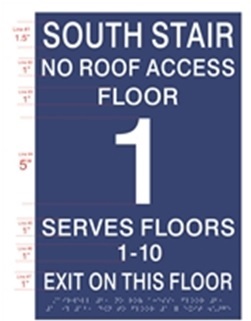The Importance of Braille Stairwell Signs in Offices and Establishments
A visually impaired individual walks into your establishment, eager to participate in all that you have to offer. However, without clear and accessible signs, they find themselves struggling to confidently move through the space. They run into a stairwell, and the absence of warning signs causes a terrible mishap that could have been averted.
Without even taking into account the possible loss of public confidence in your brand, damages, fines, and legal costs can add up quickly. However, by installing braille stairwell signs, you may make life easier for people with visual impairments and ensure their safety. Doing so drastically lowers the possibility of mishaps and consequent legal complications.
How Do Braille Stairwell Signs Work?
The installation of Braille stairwell signage is an important step for making buildings accessible and usable by people with visual impairments and cognitive disabilities. These are signs being put up for visually challenged people to feel and know where they're at and where they're supposed to step next. That is exactly what braille stairwell signs do!
These ingenious signs make use of the braille system, which enables the visually impaired to read via a series of raised dots. It's like a code that only your fingers can crack! Floor numbers, stairway directions, and other useful information is spelled out in dots to help people more easily and safely navigate an area.
Accessible signage like this allows people with visual impairments to navigate a building without assistance. They may move ahead without constant external direction. Instead, the braille signs become reliable friends who help them navigate the world on their own terms.
Braille Stairwell Signs and ADA-Compliance
The installation of Braille stairs signage is an integral part of achieving ADA compliance. People with disabilities are guaranteed equal treatment under the ADA. To this end, the ADA requires that all publicly accessible buildings meet certain accessibility standards. To aid those who are blind or visually impaired get around, braille signs are used.
Property owners and managers have a legal obligation to make ADA-compliant modifications for people with disabilities. For that reason, braille stairs signs must be installed. You won't have to worry about finding a suitable provider, as there are several businesses that offer such signs including us here at Braille Sign Pros.
Enhancing Accessibility with Braille Signs in Business Establishments
Adding more than just braille to stairwell signs is a great first step in making businesses more accessible for those with visual impairments. To create a space that is accessible to all, it is important to install a number of additional braille signs. Let's learn more about the several braille sign options that can greatly increase accessibility in commercial spaces.
Restroom Signs
Restroom signs are essential braille signs that should be provided in every public building. This signage not only shows where the closest restrooms are located but also specifies if they are gender-neutral or reserved for specific users.
Elevator Signs
Elevator indicators are also a crucial part of making a building handicap-accessible. Signs like these should be appropriately placed near elevators and near the floors they service.
Doorway Signs
Doorway signs are essential in providing clarity and easy identification within a business establishment. Not only do these indicators point in the right way, but they also identify the destination space by name.
Emergency Exit Signs
Everyone, but especially those who have trouble seeing, should always feel secure. This highlights the critical need of installing large, legible braille emergency exit signs in all commercial buildings. These signs need to be positioned in such a way that anyone in need of an exit can find one quickly.
Information Signs
Informational signs help customers learn the basics about the place they are visiting. This covers operation hours, contact info, and policies. For the visually challenged, this material may be difficult to find without braille.
Crucial Considerations for Braille Signs
There are a number of crucial considerations that must be made during the installation of braille signs to ensure their efficacy. First, braille signs should be positioned where they may be seen by people who use them. The optimal placement of these signs is crucial to ensuring a stress-free visit for those with vision impairments.
Second, readability is really important. Users should be able to easily decipher the information on Braille signs because they should be made with easy-to-read design and manufacturing. Signs made from high-quality, long-lasting materials can withstand the elements and daily use without losing their readability.
Finally, it's crucial for companies to monitor their signs and fix them as needed. Fading or deterioration of signs over time could make them difficult to read. Braille signs can continue to serve their purpose with minimal interruption if they are regularly serviced.
The use of braille signs in a variety of locations throughout a building can greatly improve accessibility. Each braille sign, whether it be for a stairway, restroom, elevator, door, emergency escape, or information board, plays an important role in making the building accessible to those with visual impairments.
Businesses may show they care about making their spaces accessible to everyone by making the effort to post braille signs in prominent places, utilizing long-lasting materials, and checking for legibility. Using braille signage shows not only a commitment to accessibility for all people but also a deep appreciation for the unique contributions of all people.
Let's join forces to make the world more welcoming and accessible for everyone.
BrailleSignPros.com provides a large variety of professional tactile signage for your company. Explore the variety of tactile signs we offer today.







Comments
Post a Comment